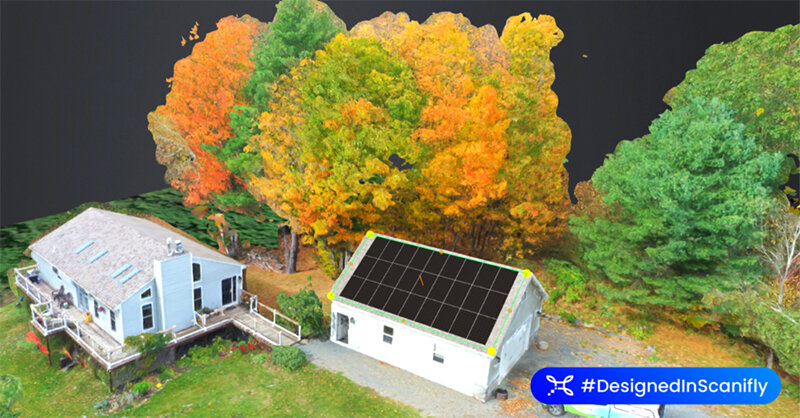
Energy Trust has approved Scanifly, a drone-based solar shade analysis and design software, as a qualifying tool for conducting solar resource assessments to meet incentive program requirements. Scanifly reports can now be submitted as eligible documentation to help complete an Energy Trust solar incentive application packet. Because of the unique capabilities of the platform, Scanifly reports can be used to show that a project meets either the on-site shade analysis requirement to take shade measurements at specific locations or the remote shade analysis requirements using an average value across the solar array. More information about Energy Trust shade analysis requirements is provided below and in the program guide online.
Scanifly’s software leverages drone imagery and artificial intelligence (AI) to help contractors reduce time, improve safety, and increase the accuracy of residential and commercial solar site assessments. The drone collects imagery of a property, and Scanifly’s software creates a scale 3D model, which includes all surface and roof measurements and any nearby obstructions. This allows workers to remain off the roof during the site assessment and system design phase, increasing worker safety and dimensional precision. Scanifly’s software allows users to conduct multiple assessment and design functions, including creating arrays, simulating validated shading analysis, forecasting production, and exporting files to CAD. For detailed instructions on how to use Scanifly to meet program requirements, please refer to the Energy Trust solar program website.
Scanifly has also been approved by other incentive administrators like NYSERDA, MassCEC, and the California Energy Commission (CEC). If you are interested in learning more about Scanifly you can review a case study on their website or watch a pre-recorded overview and demonstration of the software online.
Reminder about Energy Trust requirements for shade analysis:
Solar resource assessments evaluate the impact of shading, array tilt and orientation on the annual generation of the solar electric system. The Total Solar Resource Fraction (TSRF) estimates the combined effects of shading, tilt and orientation on a system’s performance.
Energy Trust requires Solar trade allies to verify TSRF for a proposed project by submitting a solar resource assessment from an approved shade analysis tool using one of the two approved methods:
On-site Shade Analysis—If you are qualifying your project using individual shade measurements taken from specific locations on the roof—like you would with a Solmetric Suneye—Energy Trust requires all points on a solar array to have a TSRF of 75% or greater to be eligible for solar incentives. Projects may include modules with a TSRF of less than 75% if the modules are electrically isolated using microinverters, but those modules will not be eligible for incentives. Trade allies must submit a solar resource evaluation report using an approved shade analysis tool and showing the measurement taken from the point on the array with the lowest TSRF.
Remote Shading Analysis—If you are qualifying your project using a shade analysis tool that measures average TSRF over the whole solar array, Energy Trust requires that each plane of the array(s) have a TSRF of 80% or greater over the array’s surface to be eligible for incentives. Trade allies must submit a solar resource evaluation using an approved shade analysis tool and showing that each individual solar array has an average TSRF of 80% or greater.
For more information on solar shade analysis requirements, please contact solar@energtrust.org.

